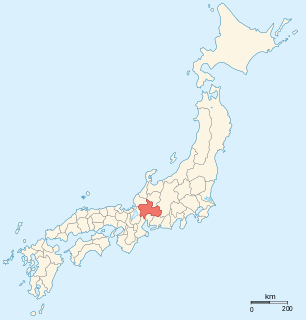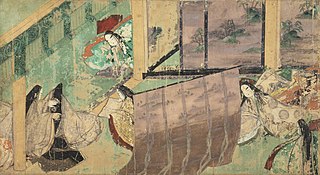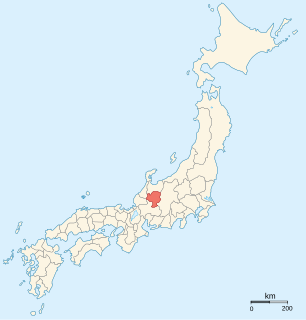
Hida Province was a province of Japan in the area that is today the northern portion of Gifu Prefecture in the Chūbu region of Japan. Hida bordered on Echizen, Mino, Shinano, Etchū, and Kaga Provinces. It was part of Tōsandō Circuit. Its abbreviated form name was Hishū (飛州). Under the Engishiki classification system, Hida was ranked as a "inferior country" (下国) and a middle country (中国) in terms of its importance and distance from the capital. Currently, the entire area of the former Hida Province consists of the cities of Hida, Takayama and most of the city of Gero, and the village of Shirakawa, in Ōno District.

The Toki clan is a Japanese kin group.

Kanō-juku was the fifty-third of the sixty-nine stations of the Nakasendō. It is located just south of JR Gifu Station in Gifu, Gifu Prefecture, Japan. During the Edo period, it was an independent post town that was approximately 2.3 km (1.4 mi) wide, making it the largest post towns in Mino Province.

Kawate Castle was a castle that existed between the Nanboku-chō period and the Sengoku period. Its ruins are located in the present-day city of Gifu, Gifu Prefecture, Japan. An alternative way to write its name in Japanese is 革手城, which has the same pronunciation. It replaced Nagamori Castle as the base of operations for the area and served as home for regional shugo until Saitō Dōsan switched to Inabayama Castle. After its demolition, earthen mounds still remained, but they, too, were broken down to help with the construction of Kanō Castle.

Sōfuku-ji (崇福寺) is a Buddhist temple located in Gifu, Gifu Prefecture, Japan. The temple has strong ties to both Saitō Dōsan and Oda Nobunaga. Gifu's Sōfuku-ji is famed throughout Japan for both the number of monks it produces and for its "Blood Ceiling". Shortly after its founding, it was also known as Kōsai-ji (弘済寺), but that name is no longer used. It is also one of the Mino Thirty-three Kannon.
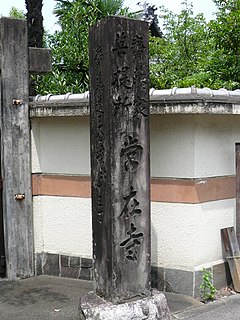
Jōzai-ji (常在寺) is a Buddhist temple of the Nichiren sect in Gifu, Gifu Prefecture, Japan. Its formal name is Shūrinzan Jōzai-ji (鷲林山常在寺). Starting with Saitō Dōsan, Jōzai-ji served as the family temple for the Saitō family for three generations, which included his son, Saitō Yoshitatsu, and his grandson, Saitō Tokugen. Also, it has been designated as a nationally Important Cultural Property, as it contains pictures of both Dōsan and Yoshitatsu.
Toki Yorinari, also known as Toki Yoriaki, was a Japanese samurai warrior of in the Sengoku period. He was shugo of Mino Province. He may be equivalent to Toki Yoshiyori, also described as a Japanese samurai warrior of in the Sengoku period.
Saitō Myōchin was a daimyō and a monk during the Sengoku period in Japan. Myōchin was the son of Saitō Sōen (斎藤宗円), who served as the guardian of Mino Province, and the younger brother of Saitō Toshinaga. He began his training as a monk from a young age at Zene-ji (善恵寺). His grave is on the grounds of Zuiryū-ji in Gifu, Gifu Prefecture.
Mino washi is a type of Japanese paper created in Gifu Prefecture, Japan. In 1985, it was designated a Traditional Craft by the Ministry of International Trade and Industry.
Toki Shigeyori was a leading military commander during the Muromachi period in Mino Province, Japan. The characters for his name can also be read as Toki Nariyori. He became the eighth head of the Toki clan at the age of 15 and was the adopted son of Toki Mochimasu. His sons included Toki Masafusa and Toki Motoyori. After becoming a priest later in life, his name was changed to Muneyasu (宗安). His remains are at Zuiryū-ji in the city of Gifu.

Sagiyama Castle was a castle built in Mino Province in Japan during the late-Heian period ; it was destroyed during the Sengoku period in the mid-16th century. The castle's ruins are located in the present-day city of Gifu, Gifu Prefecture. It stood at the peak of Mount Sagi, which was only 68 m (223 ft). Because the castle was built as a residence and not a defensive fortress, its location on a small mountain was of little consequence.

Kurono Castle was a castle built in Mino Province in Japan in 1597. Though the castle spanned the Sengoku and Edo periods, it barely did so as the castle was demolished in 1610. The castle supported the Saitō, Oda and Toyotomi clans.

Zenkō-ji (善光寺) is a Buddhist temple of the Shingon sect in Mino Province. It is a branch temple of Daigo-ji in Kyoto, Kyoto Prefecture, Japan. It is also referred to as Gifu Zenkō-ji (岐阜善光寺) and Inaba Zenkō-ji (伊奈波善光寺). It is not known when the temple was built, though it assumed to have been built between 1592 and 1600 when Oda Nobunaga was living in nearby Gifu Castle. During the early Edo period, it received the name Zenkō-ji Anjō-in (善光寺安乗院) because the two temples were merged at the time.
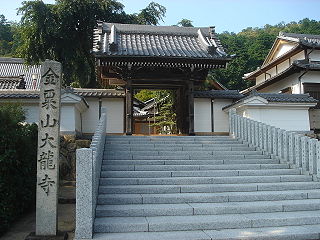
Dairyū-ji (大龍寺) is a Buddhist temple of the Rinzai school located in Gifu, Gifu Prefecture, Japan. It is one of the Mino Thirty-three Kannon. It is located near the Takatomi-chō area of Yamagata, so it is also sometimes referred to as Takatomi Dairyū-ji (高富大龍寺). Also, it has an annual festival at which daruma dolls are burned, giving it another nickname, Daruma Kannon (だるま観音).
Saitō Toshinaga was a daimyō during Japan's Muromachi period. He was the son of Saitō Sōen (斎藤宗円), shugo of Mino Province, and the older brother of Saitō Myōchin, making him the uncle of the warlord Saitō Dōsan. By his first wife, he was the father of Saitō Toshifuji (斎藤利藤) and Saitō Noriaki (斎藤典明). His second wife, who was born into the Akamatsu clan, birthed Saitō Myōjun (斎藤妙純), Saitō Toshiyasu (斎藤利安), Saitō Toshitsuna (斎藤利綱) and Saitō Toshitaka (斎藤利隆).

The Siege of Inabayama Castle of 1567 was the final battle in Oda Nobunaga's campaign to defeat the Saitō clan in their mountaintop castle and conquer Mino Province, Japan. It was a short two-week siege, fought between 13 and 27 September 1567, or in the Japanese calendar: from the 1st to 15th day of the 8th month, in the 10th year of the Eiroku era, according to the Nobunaga Chronicle. The siege ended in a decisive battle and victory of Nobunaga's combined forces, and resulted in the subjugation of the Saitō clan, their vassals, and allies. This victory was the culmination of Nobunaga's Mino campaign, waged intermittently over the previous six years, and brought an end to a rivalry between the Oda clan of Owari Province and the Saitō clan of Mino, which began over twenty years earlier between Nobunaga's father, Oda Nobuhide and Saitō Dōsan.
